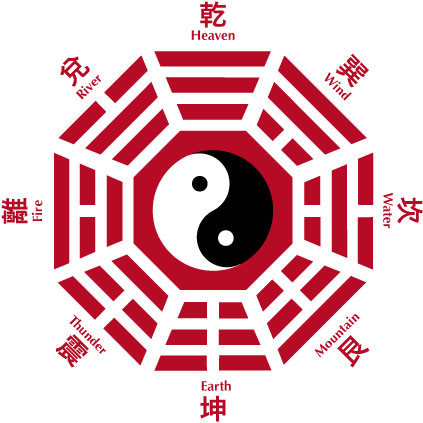Reply
Mon 21 Nov, 2011 12:15 am
Context:
The 2nd tier was encompassed by 64 yellow flags, one for each set of oracular lines in the Book of Changes, divided into in 8 groups of 8. On the top tier stood 4 men, hair tightly bound and heads capped, wearing black robes of thin silk, wide sashes emblematic of the phoenix, vermilion shoes, and squared kilts. At front left, one man held up a long pole fledged at the tip with chicken feathers to catch any sign of the wind. At front right, another held up a long pole with the banner of the Seven Stars fastened to the top to show the direction of the wind. At the left rear, a man stood respectfully holding a precious sword; at the right rear, a man held a censer. On the outside, the platform was surrounded by 24 men holding, severally, emblemed flags, ceremonial canopies, large halberds, long dagger-axes, ritual gold battle-axes, white yak-tail banners, vermilion pennants, and black standards.
each flag corresponded to a particular set of I Ching lines.
@MontereyJack,
MontereyJack wrote:
each flag corresponded to a particular set of I Ching lines.
Thanks.
But I don't get you well.
Do you mean "one" refers to "one flag" (that is: one of the 64 flags)?
@oristarA,
You haven't quite got it yet.
There were 64 lines, and there was one flag corresponding to each line. So there were 64 flags.
(This is what "one for each line" means)
Still not quite it. The I Ching is an ancient Chinese oracular system. It consists of 64 sets of 6 lines (also called a hexagram [hexa=6]). Each line can be either solid or broken (i.e. two pieces, rather than one). Each line thus has two possibilities.This gives you2^6 possible hexagrams, 2x2x2x2x2x2=64. It is the 64 unique hexagram combinations of 6 lines that the 64 flags represent.
@McTag,
McTag wrote:
You haven't quite got it yet.
There were 64 lines, and there was one flag corresponding to each line. So there were 64 flags.
(This is what "one for each line" means)
It is said of "one for each set of (oracular) lines," not of "one for each line." So you don't get it either.

@MontereyJack,
Quote:
Still not quite it. The I Ching is an ancient Chinese oracular system.
It consists of 64 sets of 6 lines (also called a hexagram [hexa=6]).
Yes.
Each line can be either solid or broken (i.e. two pieces, rather than one).
That's right.
Each line thus has two possibilities.
Either being yin or being yang
This gives you2^6 possible hexagrams, 2x2x2x2x2x2=64.
Mathematically correct. But the explanation would easily lead to confusion. the 64 comes from the combination of two EDs ( ED stands for the Eight Diagrams ). 8x8 =64. See the pic in the bottom of this post
It is the 64 unique hexagram combinations of 6 lines that the 64 flags represent.
The expression seems a bit difficult to understand. 6 lines is a set of lines. Being a set, now we have 64 sets.
One ED (the Eight Diagrams) has 8 sets of lines:

@oristarA,
Quote:It is said of "one for each set of (oracular) lines," not of "one for each line." So you don't get it either. Very Happy
I was explaining the English to you, not getting into abstruse Chinese cultural details.
Which happen to think I did rather well.